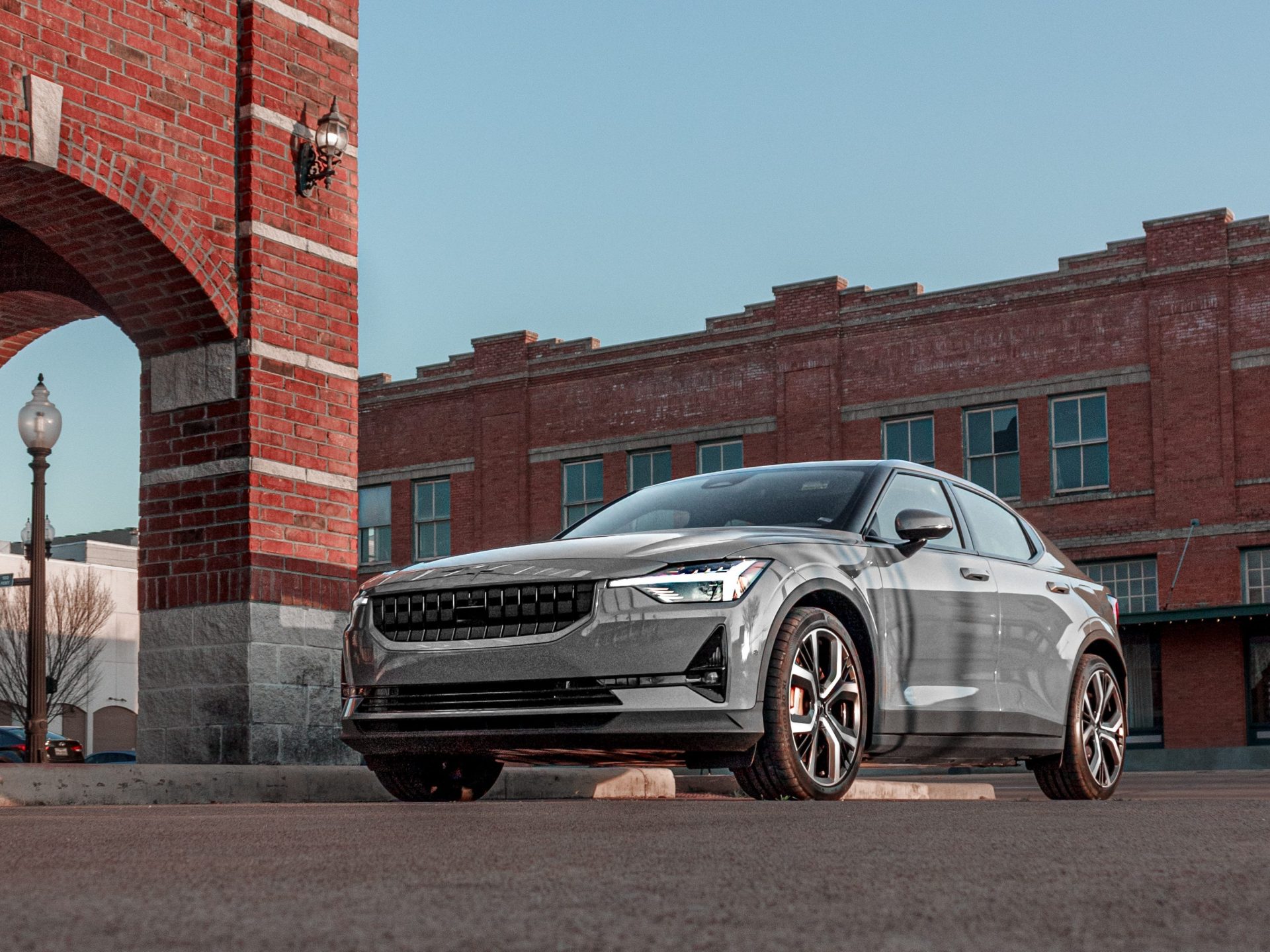Business Insider
The Polestar 2.
Alanis King
The Polestar 2 is a luxury electric car from Volvo’s young EV brand, Polestar. It starts at $49,800.
It comes in a single-motor version and a dual-motor version, and it competes with the Tesla Model 3.
We drove a Polestar 2 for a week. It was hypnotically good.
It was 75 degrees and overcast when I pulled up to an old brick building, its vintage-chic teal-and-white window trims overlooking railroad tracks that ran next to it. My car — a slate-gray, $65,000 Polestar 2 — made a low, artificial hum as I parked. I stepped out in heeled black combat boots and a spiky metal necklace, feeling like the version Avril Lavigne I always wanted to be when I was a kid.
The scene dripped of retrofuturism and affluence, like a dramatic car commercial. And for a moment, so did I.
The Polestar 2’s gold brake calipers.
Alanis King
The 2 is an electric sedan from Polestar, a new EV brand by Volvo. It offers two main options: a single-motor model that starts at $49,800 and a dual-motor at $53,300. The 2 competes with the Tesla Model 3, which starts at $46,990 and benefits from Tesla’s brand visibility — something Polestar’s EV operation still needs to build.
When buying a 2, the choice comes down to performance versus range. The single-motor has front-wheel drive, 231 horsepower, and 270 miles of range between charges. The dual-motor has all-wheel drive and gets a huge bump to 408 horsepower (or more, depending on options), but those extras knock its range down to 249 miles.
The Polestar 2.
Polestar
My loaner was a dual-motor 2 with $14,000 in options, including extra driver-assistance technology, an upgraded Harman Kardon sound system, a panoramic glass roof, a $1,200 “Thunder” gray paint job, and more. It all came to $64,600 after options and fees.
How the Polestar 2 looks and feels
The 2 is boxier than most sedans, with its front end smoothing into a flat snout and its rear doing the same. A small sticker on its side says “Polestar 2 | Battery Electric Vehicle” in a clean font, and the Polestar logo — a sharp four-point star — sits on its nose.
The Polestar 2.
Alanis King
Its face is an intimidating scowl, with a long, thin grille sitting in between two of Volvo’s signature “Thor’s hammer” headlight assemblies. They each light up in a sideways “T,” like two horizontal snake eyes.
When you see the 2 on the road, it’s like an HGTV kitchen: familiarly unfamiliar. The bones are there — the kitchen has all the counters and cabinets that yours does at home, and the 2 has headlights and taillights similar to those of its Volvo siblings — but just like the HGTV kitchen has fancier backsplash and shiner fixtures, the 2 has curious new logos, shiny gold accents, and a minimalist style.
The Polestar 2.
Polestar
The inside is the same. Its optional panoramic roof hovers over passengers like a glass cocoon, while orange-gold seatbelts glow on top of its dark-gray seats. The seats are covered in “WeaveTech” material, which Polestar describes as “vegan sophistication.”
WeaveTech is a fancy, tightly-wound fabric that the brand says is completely free of animal products, and it comes at no charge on the 2. If you want Nappa leather, it’s an extra $4,000.
A gold valve cap on the Polestar 2.
Alanis King
The 2’s interior is simple, airy, and spacious. Extra buttons and styling features don’t clutter its dashboard, and the glass roof makes it feel like the car never truly ends.
It also has a hatchback trunk, which means that when opened, a huge panel — including the rear window — lifts up. It creates more vertical space and depth, allowing for easier loading and storage.
The Polestar 2, whose hatchback trunk includes the rear window.
Polestar
At night, the 2’s headlights put on a little blinking show before you get in the car, and strips of light outline the dashboard and center console area. There’s also an Android-based infotainment screen in the center of the car’s dashboard, lighting up like a sleek black-and-orange tablet each time the car comes on.
The infotainment is easy to use, and because it’s Android based, there’s a uniqueness to it. The organization, minimalist design, and crisp orange controls on the screen’s dark background make you feel like you have a level of taste and class other drivers don’t.
The Polestar 2.
Polestar
You can control all kinds of settings with the screen, including “creep.” With creep turned on, the 2 will automatically creep forward or backward like a gas car when you take your foot off the accelerator. With it off, the car won’t move until you press the pedal. (I like using creep, mainly because old habits are hard to shake.)
How it drives
Driving a little-known luxury EV like the 2 makes you a cheetah in a nature documentary, slinking around in silence while all eyes are on you. It’s faster, more efficient, and sleeker than the gas cars around it, accelerating past them like lightning with its instant torque. It’s captivating because it looks and performs like nothing else on the road.
The Polestar 2’s headlight assembly.
Alanis King
The 2 has virtually no wind or road noise on the highway, the brakes are strong, and there’s barely any body roll. It offers two levels of regenerative braking — “low” and “standard” — and if you don’t want to use regen at all, you can turn it off.
Regen is also known as “one-pedal driving.” It allows a car to slow down without the driver using the brake pedal, meaning as soon as your foot is off the accelerator, it starts to brake on its own. The car then uses the kinetic energy from stopping to charge the battery.
The Polestar 2’s gold brake calipers.
Alanis King
Stronger regen means harsher braking when you take your foot off the accelerator, but it also means more charge goes back into the battery — extending your range and lowering your electricity bill.
It’s really a process of getting used to the feeling; when I first got into the Polestar, “standard” regen was jarring in how harshly it slowed the car down. By the end of my week with the car, it was fine.
What it lacks
I only had two real issues with the 2. The first came when I went to adjust the steering wheel and found out that it was manual, not motorized. It felt wrong in a $65,000 car.
The Polestar 2.
Alanis King
The second was the little surprises in the interior. The woven material, while beautiful, was porous, making it easy to get dust and dirt spots inside. Imagine clapping chalk erasers and getting debris on your jeans — that’s kind of what the materials in the 2 did.
Passengers also weren’t as impressed with the inside as I thought they would be. They loved the styling, but I didn’t get much of a reaction about the materials until I said the interior was vegan.
The Polestar 2.
Alanis King
Leather is still synonymous with “expensive,” and I think two things could happen here: Either people come to appreciate these woven materials over time, or companies like Polestar find a way to make their vegan interiors mimic our more traditional ideas of luxury.
Our impressions: a car that makes you feel like a star
EVs like the 2 are hypnotic, even if we haven’t fully embraced them yet. They’re new, luxurious, and rare in the US, and they will be for at least a few more years. The 2 has that same flash and flare early Teslas did, making you feel important just for stepping out of it.
The Polestar 2.
Alanis King
That feeling will wear off over time, as they always do. But we buy cars based on how they make us feel right now — and right now, the Polestar 2 makes you feel like a star.
Author Profile
Latest entries
 ScienceSeptember 20, 2024What do young voters think about the 2024 election?
ScienceSeptember 20, 2024What do young voters think about the 2024 election? HeadlinesSeptember 20, 2024‘Bachelorette’ finalist Devin Strader addresses past arrest reports: ‘I know that I have made mistakes'
HeadlinesSeptember 20, 2024‘Bachelorette’ finalist Devin Strader addresses past arrest reports: ‘I know that I have made mistakes' ScienceSeptember 19, 2024Deadly snail venom could make diabetes medicines better
ScienceSeptember 19, 2024Deadly snail venom could make diabetes medicines better HeadlinesSeptember 19, 2024Video shows former Dodgers pitcher Julio Urías's domestic violence incident outside MLS match in 2023
HeadlinesSeptember 19, 2024Video shows former Dodgers pitcher Julio Urías's domestic violence incident outside MLS match in 2023

